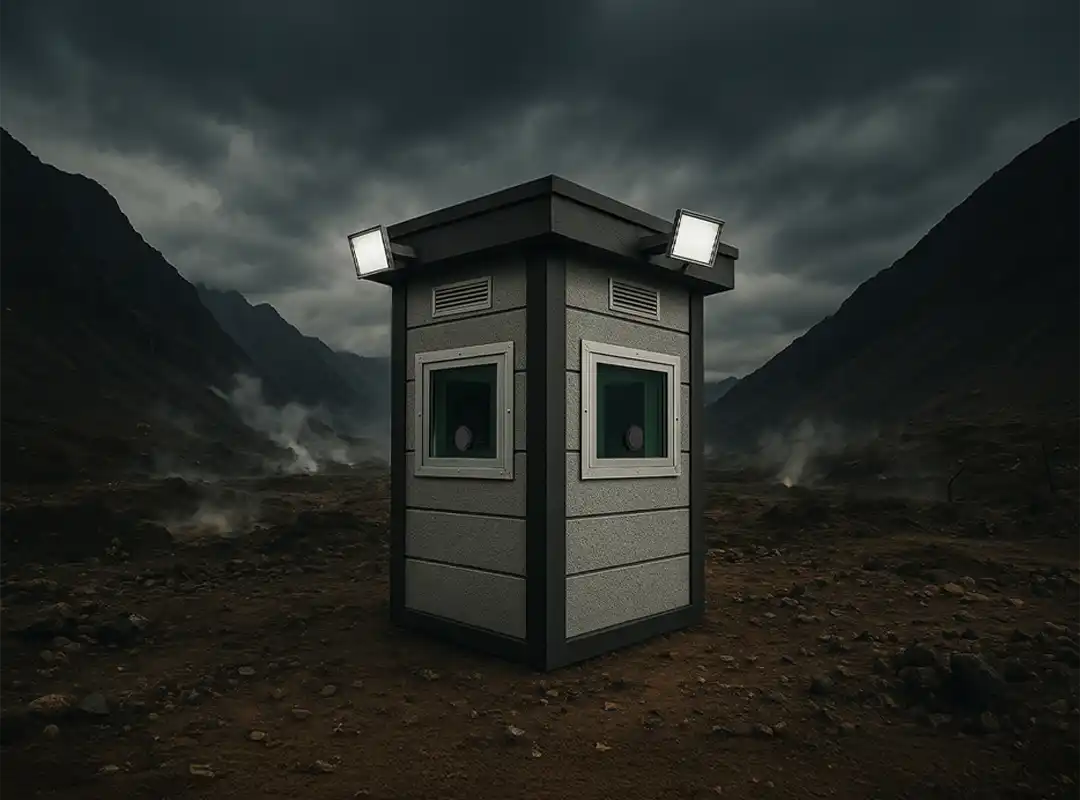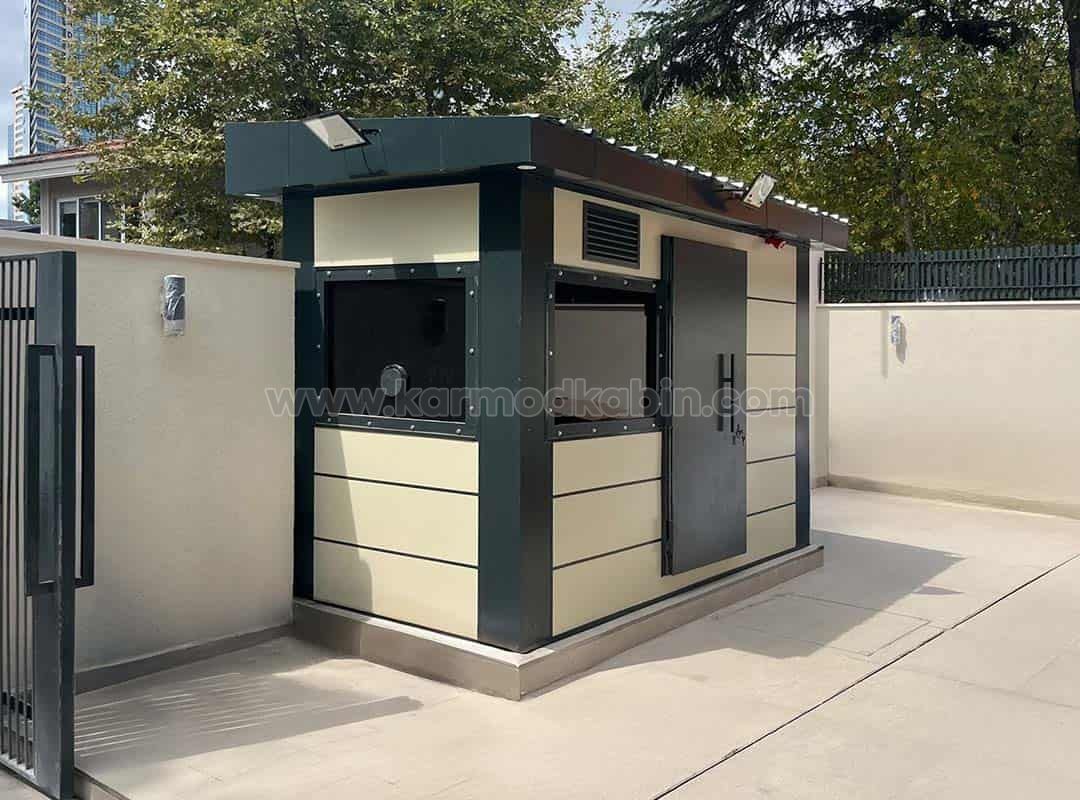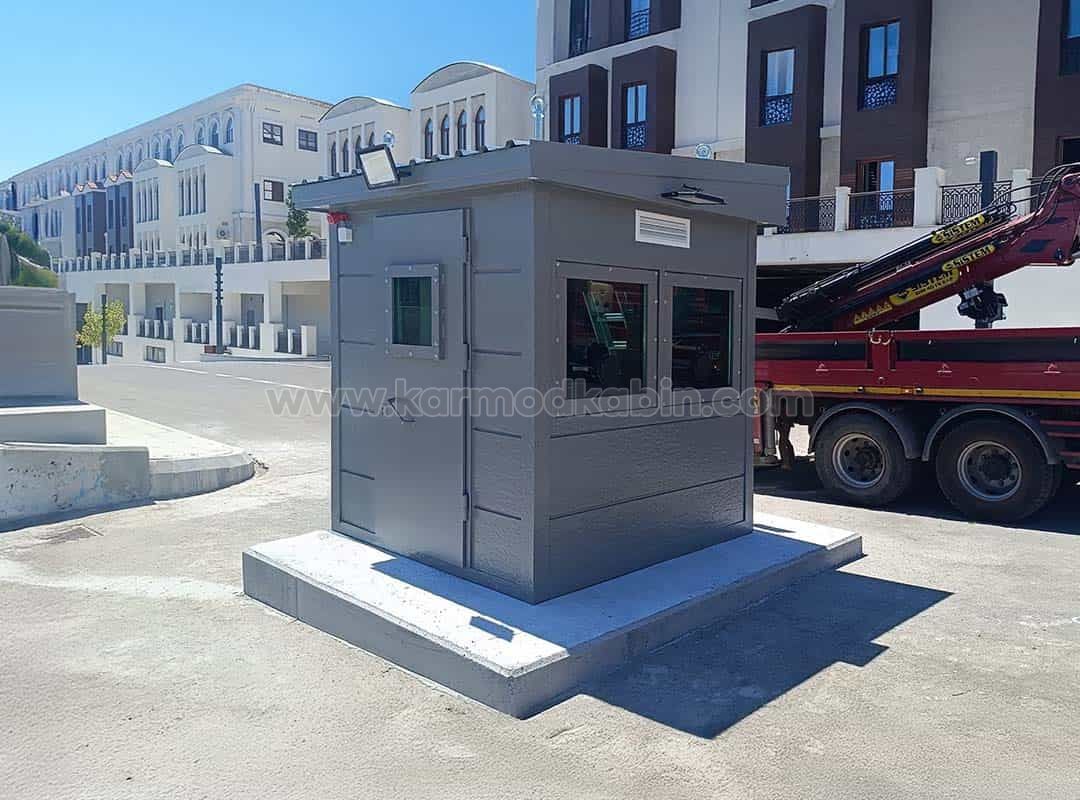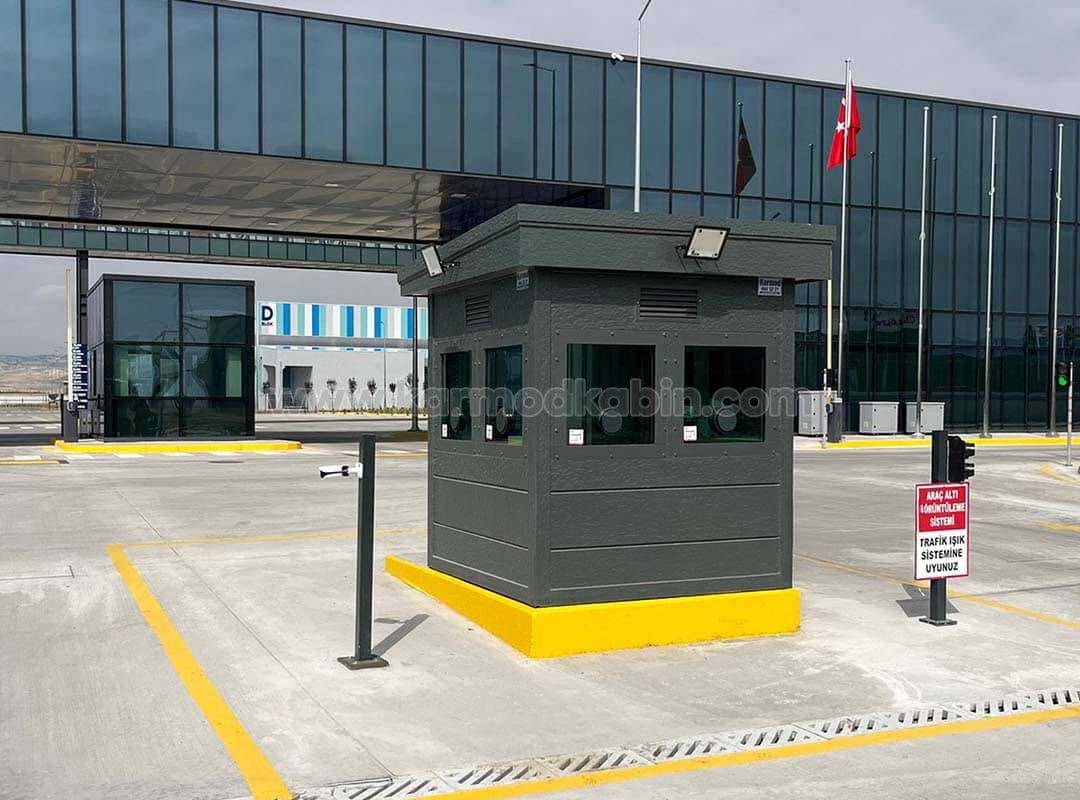
In today’s world, where safety concerns are becoming increasingly complex, armored cabin models have become an indispensable solution for operations in high-risk zones. These specially engineered structures are designed to protect lives and assets in environments exposed to armed threats, explosions, or extreme weather conditions. From military bases and border checkpoints to embassies, construction sites, and critical energy facilities, armored cabins provide a secure, reliable, and mobile shelter. Built with advanced ballistic steel, reinforced glass, and multilayer insulation systems, these cabins ensure maximum resistance against external threats while maintaining full functionality and comfort inside.
Unlike standard portable cabins, armored versions are developed through military-grade design principles, combining engineering precision with operational efficiency. They are not just shelters but strategic safety units capable of serving multiple purposes - command centers, observation points, guard posts, or even temporary control stations. With their modular configuration, armored cabins can be deployed rapidly and adapted to different terrains or missions. Whether for governmental, industrial, or private use, these cabins deliver what matters most in critical operations: uncompromising protection, mobility, and reliability.
Operating in high-risk zones requires more than ordinary shelter - it demands complete protection against ballistic and environmental threats. Armored cabins are designed precisely for this purpose. These structures serve as the first line of defense in regions where human life and infrastructure are exposed to potential danger, such as military frontlines, energy plants, or border control points. By incorporating reinforced steel frames, bullet-resistant walls, and impact-absorbing layers, they ensure safety under extreme conditions. Even in conflict areas or unstable regions, armored cabins maintain functionality, allowing security personnel, engineers, and technicians to perform their duties without compromise.
Their importance also lies in the mobility and versatility they offer. Unlike concrete bunkers, which are static and costly, armored cabins can be transported, installed, and reassembled wherever needed. This adaptability provides immediate protection in emergency deployments, temporary command setups, or disaster recovery operations. For government organizations, defense units, and industrial operators, they represent a strategic asset - a balance of mobility, durability, and tactical safety that supports uninterrupted operations in the most unpredictable environments.
Where armored cabins make a difference:
By providing both protection and mobility, armored cabins redefine safety standards in all high-risk sectors.

Modern armored cabins are developed through a combination of cutting-edge engineering and functional design principles. Each cabin is built to perform efficiently under pressure while offering maximum protection for its occupants. The structure typically features a multi-layered protection system, including ballistic steel walls, reinforced door and window frames, and shatterproof security glass. These cabins are tested against real-world ballistic standards, ensuring resistance to projectiles, shock waves, and explosions. Every corner, weld, and surface is meticulously constructed to eliminate weak points, while integrated sealing systems prevent dust, gas, or water intrusion - vital in contaminated or unstable areas.
At the same time, the modern design approach prioritizes comfort, visibility, and operational efficiency. Interior spaces are equipped with advanced ventilation, air conditioning, and communication systems, allowing personnel to work for long hours without fatigue. Ergonomic layouts provide ample room for monitoring equipment, weapon storage, or emergency supplies. Exterior design also emphasizes practicality - modular configurations enable rapid installation, relocation, or expansion depending on mission needs. This fusion of security and comfort transforms armored cabins from static shelters into intelligent, mobile protection units ready for any critical task.
Key features of modern armored cabins include:
Modern armored cabins are not only built to resist - they are engineered to empower, ensuring safety and efficiency wherever danger exists.
The foundation of every armored cabin lies in its material technology - a science of balancing strength, weight, and resistance. Each unit is constructed using military-grade ballistic steel with carefully calculated thickness levels that can withstand direct fire, shrapnel, and blast pressure. This reinforced steel is complemented by multi-layer composite plates that absorb and disperse impact energy, preventing structural penetration. Critical zones such as doors, corners, and window frames are double-reinforced, as these are typically the most vulnerable areas during an attack. In addition, bullet-resistant glass is produced using laminated polycarbonate layers that can stop high-velocity rounds without compromising transparency. The result is a structure capable of withstanding extreme external force while maintaining a professional working environment inside.
To ensure full protection, modern armored cabins are designed according to international ballistic protection standards such as EN 1522/1523, NIJ 0108.01, and STANAG levels. Each model is tested under controlled conditions, simulating real-life ballistic and explosive impacts. This engineering precision allows the cabins to provide customized protection levels - from light firearm resistance to high-caliber or explosive-grade security. By combining reinforced steel frames, ballistic glass systems, and advanced composite layers, manufacturers create cabins that stand as mobile fortresses, trusted by defense agencies, embassies, and private security firms around the world.
Core materials and ballistic protection features:
Through these advanced materials, armored cabins achieve what conventional structures cannot - maximum security without sacrificing mobility or usability.
When it comes to protecting lives in high-risk environments, compliance with international safety standards is not optional - it’s essential. Every armored cabin model must undergo rigorous testing to verify its ability to resist bullets, blasts, and external pressure. Modern manufacturers build these units according to globally recognized standards such as EN 1522/1523 (European Ballistic Classification), NIJ 0108.01 (U.S. National Institute of Justice), and STANAG 4569 (NATO Standardization Agreement). Each test simulates real combat or attack scenarios, evaluating the cabin’s performance under different calibers, angles, and distances. These results determine the cabin’s ballistic resistance level - ensuring that users know exactly what degree of protection they’re receiving before deployment.
Compliance extends beyond materials - it covers every operational and safety detail. Doors, hinges, windows, ventilation systems, and even electrical components are engineered to meet the same protection grade as the cabin’s body. Regular third-party inspections and certifications guarantee consistency and reliability across production batches. For security forces, industrial firms, or government agencies, these certifications provide peace of mind: proof that the structure has been built and tested to perform under life-threatening conditions. Choosing a certified armored cabin means investing in proven engineering, verified durability, and unquestionable safety.
Most recognized standards and certifications:
Certified armored cabins provide more than security - they deliver verified assurance that every millimeter of protection has been tested, approved, and trusted to perform when it matters most.

Armored cabins are essential assets for organizations operating in environments where safety cannot be left to chance. In military and defense zones, these structures serve as command units, observation posts, guard shelters, or temporary operation centers, providing full protection to personnel stationed on the front lines. Their ballistic-resistant walls and reinforced doors ensure that soldiers and officers remain safe even under direct fire or explosion impact. Armored cabins also offer communication and surveillance integration, allowing field operators to maintain control and visibility during missions. Their modular design enables rapid deployment and relocation, a crucial advantage in mobile military operations or shifting conflict zones.
Beyond defense, armored cabins play a vital role in industrial and security operations. Energy companies, construction firms, and mining enterprises often work in remote or politically unstable regions where physical threats are a concern. These cabins act as security checkpoints, control rooms, or staff shelters, protecting engineers and technicians from environmental hazards or hostile actions. Even in urban settings - at airports, embassies, or critical infrastructure points - armored cabins provide a permanent layer of protection for security forces and civilians. Their adaptability and strength make them indispensable for both temporary missions and long-term strategic facilities.
Common applications of armored cabins include:
With such wide-ranging applications, armored cabins are not just protective units - they are mission-ready solutions that ensure security wherever risk exists.
Modern armored cabin models are not limited to defense and safety - they also deliver remarkable comfort and functionality, even under the most extreme conditions. Unlike the claustrophobic and rigid shelters of the past, today’s armored cabins are designed to provide a livable and efficient environment for personnel who may spend long hours on duty. Each unit includes temperature-controlled interiors, ergonomic seating arrangements, and optimized spatial planning that ensure both mental and physical comfort. High-efficiency insulation prevents overheating or cold drafts, while noise-reduction materials create a calm interior atmosphere - even when activity outside is intense. This attention to human comfort improves focus, endurance, and morale during extended missions.
Functionality is equally important. Armored cabins can be equipped with integrated communication systems, surveillance screens, emergency lighting, and power backups, turning them into fully operational control centers. Every component is built to military-grade durability, ensuring smooth operation even after impact or shock exposure. Cable management, wall-mounted storage, and anti-slip flooring further enhance safety and organization inside. These design choices make armored cabins not only protective barriers but high-performance work environments, ready to support defense, monitoring, or industrial control tasks in real time.
Main comfort and functionality features include:
By combining human-centered design with superior engineering, modern armored cabins offer not just safety - they offer secure comfort, enabling professionals to perform effectively under maximum protection.
Every mission and operational environment carries its own level of risk - and modern armored cabins are designed to adapt accordingly. From low-risk industrial areas to high-conflict military zones, these structures can be configured to meet the exact security requirements of the user. The level of ballistic protection, for example, can be adjusted according to international resistance classes (FB4, FB6, FB7, or STANAG grades), ensuring that each cabin offers the right balance between mobility and defense. Additional layers of reinforced steel plating, composite armor panels, or explosion-resistant barriers can be integrated without compromising weight efficiency or mobility. This modular design allows operators to scale up or down protection levels depending on mission type and location.
Customization extends beyond structural defense. Clients can select specific interior configurations, communication systems, and technical integrations to match their operational needs. Some cabins include thermal imaging systems, CCTV surveillance, or remote alarm controls, while others are built with chemical and biological filtration systems for hazardous zones. Exterior options such as camouflage coatings, infrared protection, or retractable observation points can also be incorporated. The ability to customize every element - from ballistic performance to electronic infrastructure - makes armored cabins truly versatile solutions that align perfectly with both military-grade and civilian security applications.
Common customization options include:
With these flexible options, armored cabins transform from static shelters into mission-specific fortresses, fully tailored to the security demands of each unique environment.

One of the most valuable aspects of armored cabin models is their exceptional durability and long service life. These structures are engineered to perform under the most demanding environmental and operational conditions - from scorching deserts to freezing highlands. The combination of high-tensile ballistic steel, anti-corrosive coatings, and weatherproof insulation ensures that the cabin’s structural integrity remains uncompromised over time. Even after repeated relocations or exposure to harsh weather, the modular frame maintains its rigidity and protective performance. Unlike traditional bunkers or portable cabins, which require frequent repairs, armored cabins are designed for decades of reliable use with minimal upkeep.
Maintenance is equally efficient and cost-effective. Because each component - from panels to glass and door systems - is modular and replaceable, any wear or damage can be addressed without dismantling the entire structure. Regular surface cleaning, seal inspection, and corrosion checks are usually sufficient to keep the cabin fully operational. For organizations working in critical sectors, this means less downtime, lower operational costs, and greater asset longevity. Over time, the investment in an armored cabin pays for itself, not only through its protective capability but also through its lasting value and minimal maintenance demands.
Choosing an armored cabin is not simply about purchasing a secure structure - it’s about partnering with a manufacturer you can trust. Our armored cabin models are produced using advanced engineering methods, military-grade materials, and internationally certified components to ensure the highest level of protection and performance. Each design undergoes rigorous ballistic and durability testing to meet global safety standards, guaranteeing that every unit offers full reliability in the field. Whether for government agencies, industrial clients, or private security operations, we provide structures that embody precision, resilience, and cutting-edge technology.
Beyond their technical excellence, our armored cabins stand out for their customization, comfort, and long-term reliability. We work closely with clients to adapt each unit to its specific mission - from tactical guard stations to mobile command centers. Our experienced production team ensures seamless assembly, fast delivery, and on-site installation anywhere in the world. Backed by after-sales maintenance support and a transparent service policy, we make sure your investment continues to deliver protection and performance for years.
Why professionals choose our armored cabins:
Contact us today to explore our full range of armored cabin models, get expert consultation, and request a customized quotation.
Experience safety engineered to perfection - built for the world’s most demanding environments.